Joeseph P. Robinson
26 May 2005
This article started out as a hunt for information on German imperial cadet helmets. As one thread lead to another, I found that I had to learn more to figure out what I wanted. It took a long time to have it all fall into place. The book For King and Kaiser by Steven Clemente finally provided the rest of the insights I needed in English. What I found surprised me. Given a lifetime opinion of officer’s, general staffs and pre-commissioning training formed in the US Army and by reading English language accounts of mostly English officer ways, I soon found the Germans were quite different. For each and every rule there were always exceptions.
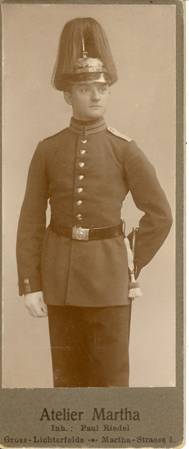
We Value Loyalty and Obedience … exclusively.
It is outside of my scope to go back to the historical foundation of the officers in Prussia but it is important to know that it came from a feudal structure with the service of vassals to the king. Nineteenth century Prussians seemed to make out as though this was some sacred bond when medieval reality was different as kings had difficulty enforcing fealty. None the less this bond of vassal to king and obedience to his will dominated the entire scene. We wanted and insisted on loyal officers. Ones we could trust through thick and thin no matter what to be loyal to the king. Led by the nobility of the eastern provinces known as Junkers , The admission to the officer ranks had to be tightly controlled to enable only the loyal obedient types to enter into this most respected and sacred profession.
Oh crud the population and army is expanding.
The first kink in the armor was size. In 1914 the army was 761,000 men, 26,000 regular officers and 25,000 officers in the reserve.[i] More officers were needed than the nobility could provide. Historically there were nobles and officers from traditional officer families. These were good solid stock that could be counted on. Now expansion would find us accepting others into the fold so the Junkers had to find a way to restrict entry into the fold to only those who had the right attitude.
In general there were three classes of people.
- The nobility and with them traditional old officer families.
- The middle class. Some quite rich but families without the benefit of nobility.
- The lower class.
Class #1 had always filled officer ranks. Now, due to the size of the Army, some of class #2 had to be let in and under no condition what so ever would anyone from class #3 enter. Some is a relative word. By 1913, 70% of the army was middle class and 48% of the generals were middle class.
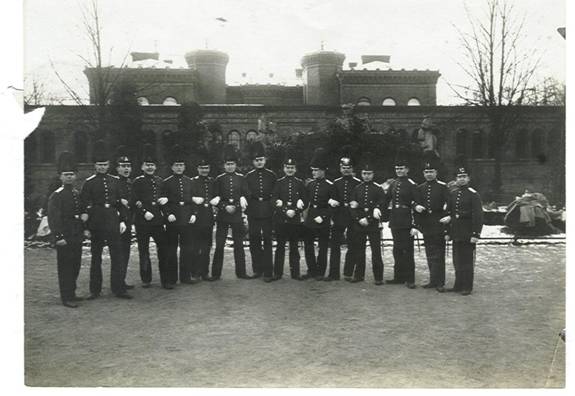
Well, if the 1st class guys had to have some #2s added in they certainly didn’t need to hang out with them. The tool to do this was the elite regiment. At first all of the #1s went to cavalry regiments. However, not all nobility could afford the extra expense of maintaining a horse etc. so the Foot Guard regiments became exclusive too. The bottom of the totem pole was the technical regiments of Pioneer and Foot Artillery. Those fields that required thinking were good for the #2s, the #1s would focus on saber waving. There was a lack of prestige as well as technical schools required. Technical schools meant having to pass courses as well as taking time.
Even by the time of the death of Fredrick the Great 10% of the army were #2s and they were all focused in Pioneer and Foot Artillery regiments. [iii] Regimental exclusiveness did not end. By 1913, 16 regiments were exclusively noble, Eighty % of cavalry officers, 48% of infantry and 41% of field artillery were noble. A few middle classers made it into the guards regiments. These were known as Concession Joes (Konzessionschulzes) and were not very welcome.[iv] An example from the 1912 Rangliste gives 36 of 36 non-nobles in IR154.
The following table gives you a feel for branches in 1861.[v]
TABLE 1
| Types of Regiments | Nobles % | Non-Nobles % |
| Infantry Guards | 95 | 5 |
| Infantry Line | 67 | 33 |
| Cavalry Guards | 100 | 0 |
| Cavalry Line | 95 | 5 |
| Artillery Guards | 67 | 33 |
| Artillery Line | 16 | 84 |
| Engineers | 16 | 84 |
* For some reason I was never able to find reference to Train Battalions. No telling where they fit but as they were not saber guys probably quite low.
Did I forget that we wanted quality?
Short answer is that is wasn’t that important. In fact it could be a threat. As more #2s entered the officer ranks with good solid skills those #1s who did not posses those skills or scores had to be protected. The American army is rife with nepotism but still the son has to have certain minimum skills. Not so in the Prussian ranks. You had to have birth, loyalty and obedience. Attitude could make up for many other failings. In all schools there were exceptions made to allow instructors to give extra credit to candidates with good attitudes. So a non-passing score could be rescued by deportment. Likewise a superb score of a #3 could be made failing by his “attitude”.
Schools were nothing like in the USA
The German school system provided the road into commissioning. Just like the US system but it is REALLY different. In today’s US world you go to primary, (8 years) secondary school, (4 years) and then, when 18 years old, college (4 years). If that college is an academy like West Point , you are commissioned at graduation. You can join the Reserve Officer’s Training Corps (ROTC) in a standard university and be commissioned upon graduation after at least a couple years of cadet training. All commissioned folks have 16 years of school a college education and a commission as a second lieutenant at about age 21 or 22. Source of commissioning matters not after young lieutenants get into their units. Nepotism (nobility) does.
Not so the Imperial German. The striking thing about the German officer is youth. Far younger than any of his western counterparts you could find officers at 17. Without talking maturity or education you find yourself looking at long service Germans rushing to get commissions and starting the clock on seniority. You could go the cadet route or the Fahnenjunker civilian route. Source of commission is very important as is nobility.
If we look at the American system everyone goes to school until age 18 and graduation from secondary school. Germans started at age 6 and had to go to age 14. This was primary school or Volksschule. Unlike western public schools Imperial German secondary school was not free to the parents. It is also VERY confusing because if the child was going to attend secondary school he transferred into a private secondary school at age 9. So parents had to start shouldering the economic costs of the education from age 9 until they could stop supporting the child. If the child would not be sent to secondary school he would remain in primary school until age 14 all at no additional cost to the parents.
So now you see why the emancipation of students became a major concern of families. Perhaps you begin to ferret out why commissioning and self sufficiency seemed so urgent. You also see that families had to decide very early (age 9) to bear this expense or not.
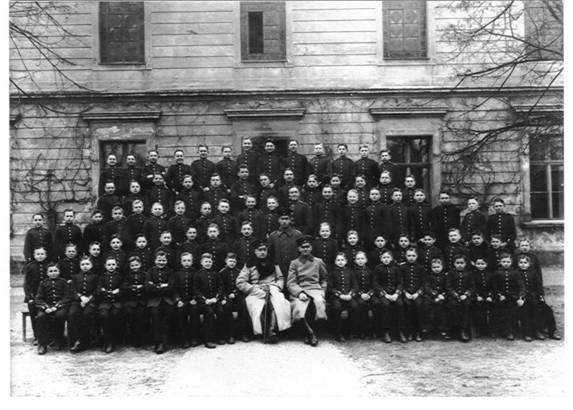
Two basic types of Secondary Schools
While there were several types and focuses there were basically 2 types of secondary schools; “6 year” and “9 year”. They were the same except for the addition of 3 more classes in the 9 year version. At the end of 6 years of secondary school you stood at the age of 14 the required schooling age.
The epitome of this education was to take an exam called the Abitur. After 9 years of school. Passing this exam guaranteed you good jobs. However you had to stay in secondary school until age 17-18 and pass a very difficult test. You could also leave school with a certificate of the highest grade qualified for. About 30% of the 9 year secondary graduates earned the Abitur.[vi]
A test taken 3 years earlier was often far more important to student and families. Known as the
One Year Certificate qualification, you could take it at the end of 6 years and if passed you qualified to be a One Year Volunteer (OYV). This meant only one year of service. The cost however was huge almost 2000 marks or the equivalent to a year in the university. Why would one do this? The advantage of being able to seek a reserve commission was worth going into debt to be a OYV. [vii]
You could also go to a cadet school. Cadets were an interesting lot. By 1910 2/3rds of the cadets were non-noble. [viii]The major investiture was the quasi-formal clothing ceremony. The picture of the Saxon Cadet I have should show how indifferent the issuers were for size of these issues of the lower cadet schools. Prussian lower schools did not wear helmets but each school had a unique uniform. If it was too large you had no recourse in this issue uniform but to grow into it. [ix] Cadet life seemed to revolve around efforts to find food as their normal fare was inadequate. Some Saxon cadets moved into the Prussian system but Bavaria stood alone and arguably always better. Saxony did maintain a separate cadet corps.
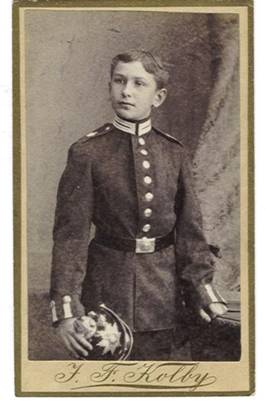
“The Doctorate is the calling card but the Reserve Commission is the open door.”[x]
German society was made of haves and have less’. To be a have you needed a commission. It didn’t make you noble but allowed you to do work in honor for a lifetime. A reserve commission allowed you to be one of the elite of society. True, not an active officer but a pretty good deal that lasted a lifetime.
You could take the OYV examination at the end of the 6th year of secondary school or after 6 years of the 9 year school. You didn’t have to finish the whole nine years. The OYV certificate acted as a diploma of sorts for many employers. An interesting point is that OYVs did not have to enter active service for their year until they were 20. So the candidate had years for education or employment.
An additional certificate, the Prima certificate was supposedly a requirement to take the Fähnrich exam. Reality in officer selection allowed for royal dispensation which ensured all the “right” folks could take the exam. Or even not take the exam and have an automatic pass. As a side, the Bavarian system was far more rigid requiring an Abitur to get a commission. As a result by 1914 only 15% of the Bavarian officer’s had noble titles. [xi]
The number of dispensations is always played down. Not that many is the conventional wisdom. Let’s take a look at test totals for a couple years:[xii]
TABLE 2
| Year | Civilians taking Fähnrich test | Cadets taking Fähnrich test | Total taking Fähnrich test | Officer test taken after was school | Selekta Cadets | Total Officers. |
| 1895 | 488 | 374 | 862 | 1179 | 82 | 1261 |
| 1900 | 344 | 351 | 695 | 970 | 88 | 1058 |
| 1907 | 315 | 337 | 652 | 925 | 63 | 988 |
Several hundred took the officer test without taking the Fähnrich test. That is quite a few dispensations and exceptions by my counting. In 1900 holders of the Abitur (and anyone with a year in University) were exempted from the Fähnrich exam[xiii]. If there were about 100 dispensations then about 200 Abitur holders skipped the exam. Of the 25,670 aspirants between 1870 and 1914 who decided to leave school early and take the Fähnrich test 43% of those were cadets[xiv].
Cadet School aspirants were far more desirable to a regiment than a civilian taking the Fähnrich test. In 1871 the senior cadet school has 700 cadets and supplied 40% of the army”s officer requirement. By 1889 the number of cadets had risen to 960 and the permanent home at Gross-Lichterfelde was established. This was the senior institution. Relate it to the civilian schools, the top 3 grades from ages 14-17. There were no less than eight junior campuses which fed the senior institution. (Köslin,Postdam,Wahlstatt, Bensberg, Plön, Oranienstein,Naumberg, and Karlsruhe .) You started at age 10 at the lower school and moved to the senior school at about age 14. Families paid for cadet school. It was not free or subsidized. The number of officers provided annually during the 20th century was 240.[xv]
The incentive again was to get these boys out to earn a wage and not burdening the families with school costs. Scholarships were available to help defray the cost and as a tool to ensure unwanted folks could not afford it.
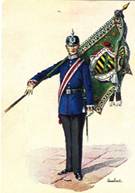
So What Were the Steps to Becoming an Officer?
As you can imagine the steps were full of exceptions and changes all aimed at ensuring the right guy got in and the wrong guy did not. The basic ten steps to commission were similar for both the civilian method, Fähnenjuker, or the cadet schools. Some of these had more exceptions than others.
Step 1. Find a Regiment
All Guard and Cavalry regiments actively recruited nobles to keep the regiments pure. Sort of like modern recruiting, all methods were used to lure the young nobleman. They used fancy uniforms and depot locations near fashionable large towns. Guard and cavalry units could expect additional income of 1000 marks per month for a candidate Remote lower regarded regiments often had problems attracting new blood. None-the-less, they insisted on a rigid class and social pick in step 2.[xvi]
The maintenance of high social standards led to great shortages. 8% short in 1889 of total officer billets. In 1902 56 infantry regiments received no applications! This was blamed on middle class folks not wanting to wade through the army’s prejudice. [xvii]
Step 2. Get Regimental Colonel to sponsor you to qualify.
This was the key and maybe most difficult step on the ladder. The family was looked at in detail as well as the candidate. Sufficient income was required and the regimental commander and his other officers didn’t want to accept a fiscal problem maker. A somewhat sad story is told by Vera von Etzel about how Artur v. Klingspor made it into the Kürassier-Regiment von Seydlitz (Magdeburgisches) Nr.7. Very expensive gear at that time and a burden even for his father, Lieutenant Gen. Leo v. Klingspor. The older brother was subsidized by his father and received his commission. But he was subsidized after his younger brother, Hans Arvid, died while in the academy. Perhaps the loss of a son required his father to make sure his surviving son was in the ‘best’. But the enormous cost of a ‘fancy’ regiment would keep the regiments populated by the more affluent – the ‘vons’.[xviii] The father and son went to a dinner to be seen by all a one night precursor of step 8. The Colonel would not give final approval until the Fähnrich exam was passed or in the bag. Cramming with a tutor for the exam was a standard practice.

Step 3. Pass the Fähnrich examination
Remember you were supposed to have a Prima certificate or dispensation to gain entry. 90% had a Prima Certificate. 75% passed the first time. You could take it again and few if any failed the second time. If indeed they did fail the second time it was into the ranks as an OR. In 1890 the Kaiser demanded leniency in grading. If leniency failed he used dispensations which totaled over 1000 between 1901 and 1912.[xix]
At the end of 6 cadet years or the age of 17 the cadets took the Fähnrich exam and merged into the commissioning process. Cadets were a little different because they were called Brevet Fähnrich. If you really did well on the Fähnrich exam you could be selected as a Selekta cadet and maintained at the school. They became cadet non commissioned officers and “ran” the non-senior cadets in the following year. There was a huge advantage of being a Selekta. If you passed the Officers exam you got commissioned. No need to be voted on buy the officers of the regiment.[xx] You could also stay at the academy, delay commissioning and try for the Abitur. The Selekta helped you for the rest of your military life. The Abitur was a civilian life advantage.[xxi] Never the less the number of military Abitur holders grew steadily from 1/3 in 1880 to 2/3rds in 1912. The number of middle class officers who saw the lifelong civilian advantages of the Abitur took sway.[xxii]
Step 4. Spend time in the ranks in the regiment
The folks that passed moved into the regiment as an OR but was referred to as an “avantageur”. Officially, the title was “Officeraspirant” that title was officially changed in 1899 to “Fähnenjunker”. He wore a portapee that identified him. He lived in the barracks for a period that varied by regiment from 6 weeks to 1 week. He started as a Gemeiner and when he moved out became a Gefreiter. All costs associated with his service were borne by him like a OYV. At this point he could also have a civilian batman.[xxiii]
When promoted to unteroffizer he got to eat at the officer’s mess. At this point he started being called Fähnrich. The word Portapeefähnrich went away in 1899. A Fähnrichsvater was appointed to be his mentor. Long drinking bouts and rules of the mess were common place. While the Fähnrich was encouraged to spend freely, indebtedness was a major embarrassment for the entire mess. Step 4 passed quicker and quicker. At first 6 months, the time shortened to three months (two if you came from a cadet school) by the turn of the century.[xxiv]
There were exceptions as some cadets left the academy with some advanced training and were considered Patent Fähnrich. They never were privates just Gefrieter.
The time in the ranks was so short folks didn’t learn the system. Only the reserve officers who went through the year as a OYV understood the difficulties of the OR.
Step 5. Be promoted to Fähnrich “if all went well”.
The aspirant applied to the colonel that he was “qualified” and deserved a military qualification certificate (Dienstzeugnis). If approved by the colonel and ALL of the officers of the regiment he was officially promted to Fähnrich and paid a salary. He also got to wear the silver sword knot. Between 1892 and 1894 for example, of the cadets 59% became Brevet Fähnrich, 10% Patent Fähnrich and about 1/3 were Selekta. [xxv]
Step 6. A course at the Kriegschule.
Cadet Abitur holders, Selekta cadets and civilian Abitur holders who had been University students for a year were exempted from this requirement. However, If you look at the ages you see that expanded civilian education took time and money whereas you could skip the education and go into the commissioning system and start making money and seniority. This course shrunk in length as the need for officers became more pressing and the desire became to commission in 1 year. At the end of the course you took the officer’s exam. This course eventually went to seven months in length.[xxvi]
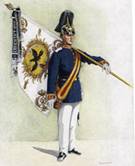
Step 7. Pass officer exam (become a DegenFähnrich) and return to regiment.
Selekta Cadets went straight to step 10 if they passed. . Passing was not a problem (98% pass with re-take option.). Obedience and attitude came before grades. It was considered far easier than the Fähnrich exam.[xxvii] At the regiment the Fähnrich waited (briefly) for a vacancy and for the next steps to be completed.
Step 8. Regimental officers balloted, to see if they agree to accept candidate.
Selekta cadets did not have to undergo this. Majority vetoes were final. Minority vetoes had to be sent to the King for decision. If you failed you were either sent to another regiment for another try or to the reserves in disgrace or with a major stigma. Few candidates failed as it required going against the Colonel’s wishes. Some were rejected in full knowledge because of a lack of personal wealth in which case the candidate was sent to another regiment without stigma. [xxviii]
Step 9. Colonel Recommends Promotion to Second Lieutenant to Kaiser
The Fähnrich became a second lieutenant and a member of the social elite. EXCEPT if you were in the Foot Artillery or Engineers. These two branches considered the newly commissioned as supernumeraries until they had served one or two years, attended technical school, and passed a qualifying exam. [xxix] Technical schools were viewed by the nobility as “schools for plumbers”. [xxx] Is there any question why the nobles eschewed these branches?
Step 10.Promotion is Officially Gazetted[xxxi]
There were all sorts of rules for seniority and backdating dates of rank but it is outside my scope to dwell on these. Abitur holders finally got payback and got their dates of rank predated 2 years.
Congratulations you are an Officer or “Trick or Treat you are in the Fleet”.
Being one of the elite you found yourself in another world. There were no rules for promotion. That’s right no rules. Seniority and noble connections both mattered. A normal progression was 8 years, to First Lieutenant, 14 to Captain, 25 for Major, and 30 for Lieutenant Colonel. Pay was not reasonable as it was 1/5th of his American counterpart.[xxxii]
Low pay with high status meant that marriage had to be a business deal where the girl brought the “bacon” to the table. It was not unusual to use a marriage agency nor for the brides father to assume the officer’s existing debts. Marriage had to be approved by the regimental commander to ensure the woman had enough money and an unblemished record. [xxxiii] Have you ever noticed how unhappy German brides look in their wedding pictures? Maybe it was cultural. At least my wife smiled when we got married.
So life wasn’t always rosy but now we know how you got to this social plateau. Clemente’s book was heavily relied on for citations in this article but as you can see the pages and information had to be rearranged. What are my conclusions?
- Prussian Officers were far younger and less well educated than their western counterparts.
- Wealth and social position drove the train.
- There were many regiments where the have – less types resided.
- For every rule there were exceptions made for the right person.
So there it is in short (well sort of not exactly 300 pages.). Have at it all critiques very welcome.
——————————————————————————–
[i] Clemente, Stephen, For King and Kaiser, Greenwood Press, Westport , CT , 1992, p205.
[ii] Ibid.
[iii] Clemente, Stephen, For King and Kaiser, Greenwood Press, Westport , CT , 1992, p3.
[iv] Ibid. pg 206.
[v] Ibid. pg 16
[vi] Ibid. pg 32
[vii] Ibid. pg 33
[viii] Op cit. Clemente, pg 111.
[ix] Ibid pg. 115
[x] Ibid. pg 115.
[xi] Ibid. pg 41
[xii] Ibid pg 258
[xiii] Ibid. g.43
[xiv] Ibid, pg. 212.
[xv] Op Cit Clemente, pg. 82-83
[xvi] Op Cit Clemente, pg 64
[xvii] Ibid. pg. 207.
[xviii] Wehrmacht-Awards thread, Prussian Commissioning, 7/28/2004 Posted by Brian S.
http://www.wehrmacht-awards.com/forums/showthread.php?t=57874&page=2&highlight=commissioning
[xix] Op cit Clemente pg 43.
[xx] Ibid pg. 94
[xxi] Ibid. pg 101
[xxii] Ibid. pg 209.
[xxiii] Ibid. pg 72
[xxiv] Ibid pg 73-74.
[xxv] Ibid
[xxvi] Ibid, pg.150
[xxvii] Ibid, pg 150-157.
[xxviii] Ibid. pgs 158-159.
[xxix] Ibid. pg 160.
[xxx] Ibid. pg 210.
[xxxi] Martin, A.G., Mother Country Fatherland, Macmillan & CO, London , 1936 pg 16
[xxxii] Ibid. pg. 161-162.
[xxxiii] Ibid. pg 163-164.

